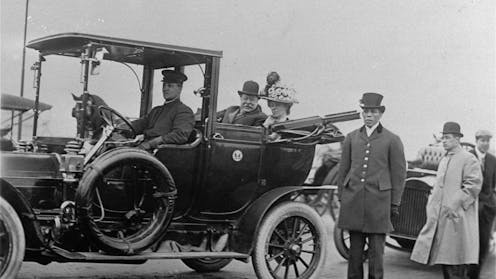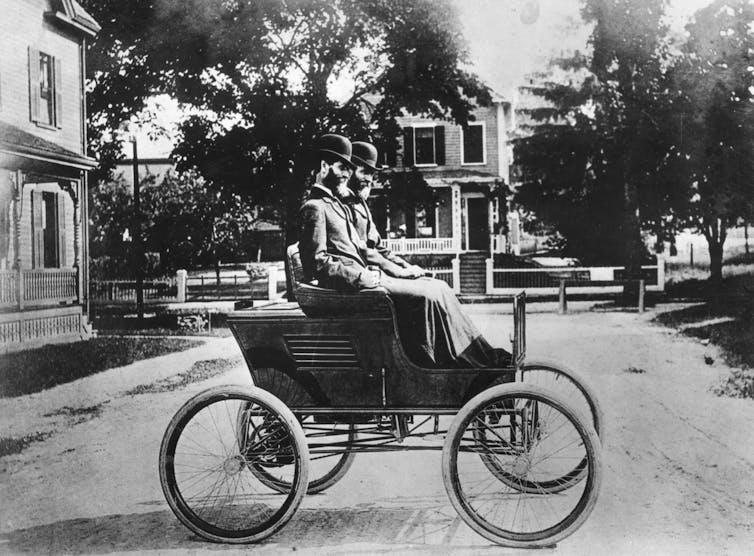Could steam-powered cars decrease the CO2 in the atmosphere?
This technology, popular when automobiles first caught on, had a short resurgence in the 1970s.


Curious Kids is a series for children of all ages. If you have a question you’d like an expert to answer, send it to curiouskidsus@theconversation.com.
Could steam-powered cars decrease the carbon dioxide in our atmosphere? – Emma, age 16, Springville, Utah
With the growing severity and frequency of storms, heat waves and wildfires, and the other dangers from climate change, there are many reasons to be concerned about the amount of carbon dioxide in the atmosphere. Scientists have shown that humanity’s addiction to burning fossil fuels is causing this problem, which means it’s time to kick that habit.
Because transportation generates more than one-fourth of the CO2 emitted by burning fossil fuels, slashing CO2 emissions requires phasing out vehicles powered by gasoline, diesel and natural gas.
Steam powered many of the early automobiles sold around 1900. Could the same technology play a role again?
The ‘Stanley Steamer’
The steam-powered car became possible once gasoline and diesel oil replaced wood and coal for the powering of engines.
Inventors Francis and Freelan Stanley, twin brothers, became automaking pioneers after they improved photographic technology. In 1898 and 1899 they were selling more vehicles than any other early automaker, and their steam-powered “Rocket Racer” set a speed record in 1906.
All along, cars powered by internal combustion engines – the kind most in use today – were competing with steam cars and winning the technology war. Starting in 1912, electric starters made them safer and more convenient by replacing dangerous hand cranks. By 1920, when its assembly lines started producing the Model T with an electric starter, Ford was selling hundreds of thousands of cars per year.
In contrast, early steam cars were heavy and expensive, and it took a long time to make enough steam to get them rolling. Doble Steam Motors, another early automaker, eventually solved this last problem and many others, but the cars remained pricey, and it was too late: The noisy and polluting but much cheaper internal combustion engine had won out. The Stanley Motor Carriage Co. ceased operating in 1924.
To be clear, because the heat to boil water to make steam has to come from somewhere, these steam-powered vehicles burned fossil fuels to heat their water anyway.

A 1970s comeback
Steam power had something of a comeback in the 1970s, but not because of climate concerns. Back then, air pollution spewed by vehicles had become a serious problem filling cities with smog.
Steam boilers can burn fuel more thoroughly than a standard internal combustion engine, leading to cleaner exhaust that is mostly water and carbon dioxide.
At the time, that was seen as an improvement.
Some of the cities battling pollution from automobile exhaust added steam-powered buses to their fleets. This resurgence was short-lived because of the arrival of new technologies that could curb pollution from internal combustion engines.

Steam’s drawback and electricity’s advantages
The biggest obstacle for steam-powered vehicles is that steam isn’t a source of energy. Rather, it is a source of power for the wheels.
While getting around in steam-powered vehicles might make the air cleaner in the drivers’ own communities, switching to steam-powered engines that continue to burn gasoline and diesel wouldn’t reduce CO2 emissions.
A different approach can potentially eliminate the need to burn fossil fuels for transportation: replacing gasoline tanks with batteries to provide the energy, along with swapping out internal combustion engines for electric motors to turn the wheels.
The reduction in carbon emissions will be far greater if vehicles run on electricity generated by wind turbines, solar panels or other energy sources that don’t emit carbon dioxide.

As it happens, some of the first cars ever made were electric. Manufacturers stopped making those models because the need to recharge their batteries after short distances rendered those vehicles less convenient than those powered by fossil fuels.
Battery technology is so much better now that some electric vehicles can travel 400 miles (640 kilometers) without needing to recharge. Instead of switching to steam as a source of power to help reduce carbon dioxide emissions, we recommend electricity generated from renewable sources.
Hello, curious kids! Do you have a question you’d like an expert to answer? Ask an adult to send your question to CuriousKidsUS@theconversation.com. Please tell us your name, age and the city where you live.
And since curiosity has no age limit – adults, let us know what you’re wondering, too. We won’t be able to answer every question, but we will do our best.
The authors do not work for, consult, own shares in or receive funding from any company or organization that would benefit from this article, and have disclosed no relevant affiliations beyond their academic appointment.
Read These Next
As millions of Americans face a steep rise in health insurance costs, lawmakers continue a century-l
US health care policy will remain fractured until lawmakers address the core question of who is responsible…
Understanding climate change in America: Skepticism, dogmatism and personal experience
Real skeptics study the evidence and ask questions, rather than taking political dogma on faith. Experiencing…
Sudan’s civil war: A visual guide to the brutal conflict
Since fighting broke out in April 2023, some 150,000 people have been killed in Sudan and an estimated…






